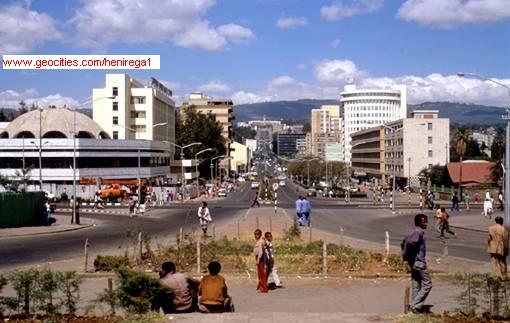|
Ethiopia
Ethiopia, republic in northeastern Africa, officially the Federal Democratic Republic of Ethiopia. Ethiopia is bounded on the northeast by Eritrea and Djibouti, on the east and southeast by Somalia, on the southwest by Kenya, and on the west and northwest by Sudan. A high plateau capped with rugged mountains covers much of Ethiopia; lowland deserts surround the plateau region. Agriculture, the country's chief economic activity, is carried out in the fertile plateau area. Ethiopia has a diverse population, with more than 70 distinct ethnic and linguistic groups. The 1994 constitution established Ethiopia as a federation and created nine regions for the country's main ethnic groups. Known as Abyssinia until the 20th century, Ethiopia is the oldest independent nation in Africa. It was home to the powerful Christian kingdom of Axum in the first centuries AD and became a Christian empire in the 15th century. After the 1500s Ethiopia divided into a number of small kingdoms, which were reunified by Menelik II in the 1880s. Eritrea, which had been part of Ethiopia since the 1950s, became an independent nation in 1993 after a protracted civil war. Addis Ababa is Ethiopia's capital and largest city.
Addis Ababa, capital and largest city of Ethiopia, the country's commercial, manufacturing, and cultural center. It is situated in central Ethiopia at an elevation of about 2440 m (about 8000 ft) above sea level on a plateau that is crossed by numerous streams and surrounded by hills. It is the focus of a highway network, the site of an international airport, and the terminus of a railroad to the Gulf of Aden port of Djibouti, capital of the neighboring state of Djibouti. In the city are printing industries, and manufactures include footwear, clothing, asbestos and metal products, processed foods, cement, and plywood. Flourishing handicraft industries produce leather, metal, and textile goods, which are traded along with the regional agricultural produce, such as coffee, tobacco, and dairy items, in the vast open-air market known as the Merkato, on the western side of the city. capital and largest city of Ethiopia, the country's commercial, manufacturing, and cultural center. It is situated in central Ethiopia at an elevation of about 2440 m (about 8000 ft) above sea level on a plateau that is crossed by numerous streams and surrounded by hills. It is the focus of a highway network, the site of an international airport, and the terminus of a railroad to the Gulf of Aden port of Djibouti, capital of the neighboring state of Djibouti. In the city are printing industries, and manufactures include footwear, clothing, asbestos and metal products, processed foods, cement, and plywood. Flourishing handicraft industries produce leather, metal, and textile goods, which are traded along with the regional agricultural produce, such as coffee, tobacco, and dairy items, in the vast open-air market known as the Merkato, on the western side of the city.
Addis Ababa is a sprawling city, well wooded, especially with eucalyptus trees, and crossed by broad avenues. Modern, multistoried buildings sit side by side with traditional one- and two-storied structures and open spaces. Its high elevation gives the city a mild, pleasant climate. The city is the seat of Addis Ababa University (1950), schools of music and art, and several research institutes. As headquarters of the Organization of African Unity and the United Nations Economic Commission for Africa, the city is the scene of many international conferences. Of note in the city are the octagon-shaped Saint George Coptic Christian Cathedral (1896), the modern Africa Hall with its dramatic stained-glass windows, and the Menelik II Palace, as well as several museums with collections of art, ethnology, and archaeology.
The modern city was founded in 1887 at the site of a hot springs by Emperor Menelik II and given the name Addis Ababa, Amharic for "new flower." It became the national capital in 1889. The city's somewhat haphazard and unplanned growth was spurred by the completion in 1917 of the railroad to Djibouti. From 1936 to 1941 Addis Ababa was occupied by the Italians, who made it the capital of Italian East Africa and instituted extensive modernization projects. Between 1960 and 1970 the population of the city nearly doubled, and new light manufacturing industries were established. In 1963 the charter establishing the Organization of African Unity was signed here. Population 3 million (2001 estimate). |
|